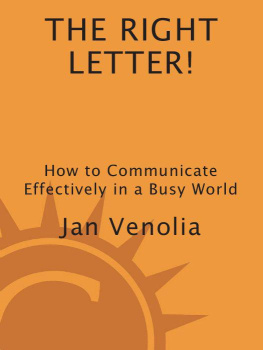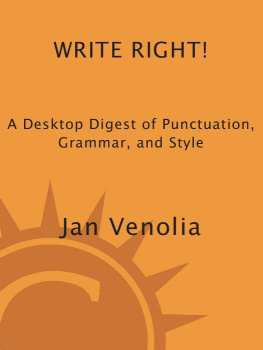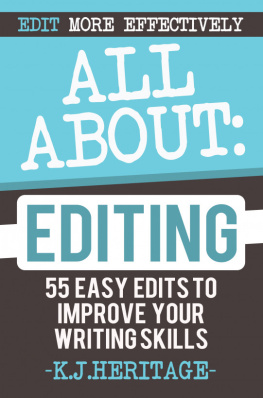Distributed in Australia by Simon & Schuster Australia, in Canada by Ten Speed Press Canada, in New Zealand by Southern Publishers Group, in South Africa by Real Books, in Southeast Asia by Berkeley Books, and in the United Kingdom and Europe by Airlift Book Company.
Library of Congress Cataloging-in-Publication Data on file with the publisher.
Mend your speech a little,
lest it mar your fortune.Shakespeare
Mend your writing, too.
Jan Venolia

Contents

Why Rewrite?I have rewrittenoften several timesevery word I have ever published.
My pencils outlast their erasers.
Vladimir Nabokov
As a writer or editor today, you have a lot more at your disposal than pencils and erasers.
- Word-processing software simplifies writing and revising, from note-taking and first drafts to final copy.
- The Internet is a reference library at your fingertips.
- E-mail makes keeping in touch with colleagues, friends, and family a snap and eases the interaction among authors, editors, peer reviewers, project managers, and production staff.
These powerful tools help you do it, but a solid foundation in the principles of revising tells you what needs to be done.
Rewrite Right! is for people who must write at work or in school and for freelance writers struggling to make sales. Editing is improving something writtenmaking it easier to follow, snappier, more interesting. Knowing how to edit means knowing what good writing is in the first place. And good writing comes from knowing how to revise, how to tug on words and adjust them until they say what you want them to say. In other words, writing and editing are facets of the same subject: doing a good job of putting ideas into words.
Have advances in telecommunications reduced the need for good writing? Not at all. The medium may change, but the language still needs to be well crafted. People who used to step down the hall to brainstorm with a colleague now sit down at a keyboard and whip out a message on e-mail.
E-mail has many advantages. Its convenient, fast, cheap, and less intrusive than a phone call; it provides a paper trail and is easily distributed to a large number of people. It allows an increasing number of people to work from their homes.
But the very ease of e-mail can be a hazard. Many people have developed an e-mail style thats breezy and informal; they pay less attention to spelling and grammar than they would in a standard letter. Should they care about good writing? You bet! E-mail recipients shouldnt have to puzzle their way through a message riddled with misspelled or omitted words and confusing references. Dont let the informality of e-mail fool you into thinking sloppiness is okay. Spontaneity is fine; sloppiness can be dangerous in any communication.
Muddled instructions create confusion. Costly research is repeated because results are buried in an obscure, two-pound report. Boring writing is tossed aside unread. Slipshod writing breeds distrust, prompting readers to wonder if language is the writers only area of incompetence.
At the other end of the spectrum, good writing gets things done. Its crisp, clear style requires less of the readers time. Good writing lowers administrative expenses, lightens workloads, and suggests the writer is competent in other areas as well.
Yet when it comes to writing, many capable people falter. They may be experts at marketing or high-energy physics, but ask them to write it up, and they rely on worn-out expressions and stilted prose.
As a consulting editor, Ive learned where most people need help. My first two books, Write Right! and Better Letters, provide simple advice.
Rewrite Right! is for those who want more. It describes two levels of editing: (1) to improve style and content, and (2) to correct language.
Rewrite Right! includes a variety of reference materials: lists of accepted abbreviations, hackneyed expressions, common redundancies, and irregular plurals. It suggests ways to make a document look better and explores sophisticated tools available to todays writers and editors. A glossary provides definitions of unfamiliar terms.
I hope Rewrite Right! helps you learn not only to write and rewrite well, but to enjoy doing it.
Writing and Editing in the 21 st CenturyDont be afraid to seize whatever you have written and cut it to ribbons. It can always be restored to its original condition in the morning.E. B. White
Especially if you have the right software.
Jan Venolia
Todays sophisticated software puts a dazzling variety of tools at your fingertips. Use them in the early stages of writing to take notes, outline, and create rough drafts. Use them in the revising process to explore various formats, insert and delete text, and rearrange paragraphs or whole sections. Use them in the final stages to add graphics and captions, introduce desktop publishing touches (e.g., borders, shading, drop caps), and print final, camera-ready copies.
The Internet as Writing Resource
The Internet is a rich source of information about writing and revising. There you will find the principles of good writing, lists of common errors, interactive quizzes, online dictionaries, guidelines for gender-fair writing, and compilations of web-based writing centers.
But you need to exercise caution, because some of the information is inaccurate or outdated. For example, William Strunks classic, The Elements of Style, is online in the original 1918 edition, not the modern version edited by E. B. White.
The very quantity of information is daunting. Arm yourself with a clear objective for your web searches, so you will be able to screen out extraneous material and reap the benefits of having the world at your fingertips.

Outlining
An outline helps break through the intimidating nature of a blank page; you feel that youve begun and can see a path to the end. An outline forces you to think about which are the more important topics, the ones to be emphasized and buttressed with supporting detail.
If you choose a standard outline format (topic, subtopic, sub-subtopic), your computer will simplify the process. You can:














